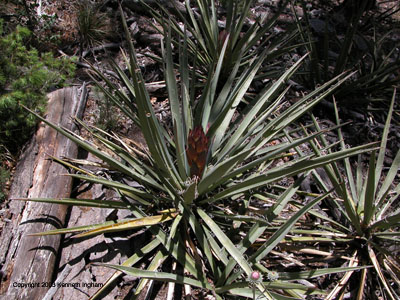Yucca baccata
 Common: Banana yucca
Common: Banana yucca
Family: Agavaceae
Origin/Range: Southwest US
Light: Full sun, takes heat; also handles partial shade
Temp: Hardy to 0°F
Water: Natural rainfall; better ornamental quality with supplemental irrigation
Soil: Sandy, rocky, good drainage
Leaves are long slender points; curved or U-shaped cross section across blade width; rough texture; small threads on margins; points on leaf end.
Flowers are on spike held 2-3ft above main clump; bell-shaped flowers usually white or greenish, sometimes reddish; bloom early to mid spring. Fruit is 4-6in long, shaped like a banana; edible.
There is a wonderful description of Native American use of yuccas, written by a Navajo Indian from the Diné Nation, at Medicinal Plants of the Southwest. Yucca roots are sold in produce sections of supermarkets today, but Native Americans and others have eaten the roots for a long time. The fibrous leaves were used to make baskets, mats, cloth, rope, and sandals. Flowers and fruits were eaten. The root, when pounded and soaked in water provided a shampoo called amole which could be used for cleaning hair, feathers, or cloth. The suds were used to represent clouds in religious ceremonies.